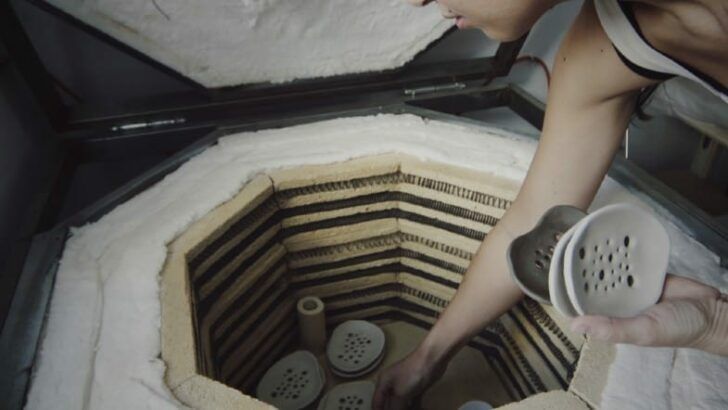What Is Refractory Clay Made Of?
What is Refractory Clay?
Refractory clay is a type of clay that has properties making it ideal for high-temperature applications. The word “refractory” means resistant to heat or fire.
Refractory clays have a high melting point, usually over 1,600°C. They are resistant to thermal shock and chemical erosion. When exposed to extreme heat, refractory clays keep their strength, shape, and chemical identity. These unique properties allow refractory clays to withstand very high temperatures, making them essential for lining furnaces, kilns, fireboxes and other high-heat equipment.
Refractory clays contain a high percentage of alumina and silica. These give refractory clay its high fusion temperature and resistance to heat. The amounts of these minerals determine the grade of the clay. Higher purity clays have higher refractoriness. Impurities lower the melting point.
Raw Materials
Refractory clay is made from several key raw materials that give it unique properties and high heat resistance:
Clay – Refractory clays contain alumina and silica. Kaolin, fire clay, and bentonite are common types of clay used. The clay provides plasticity during manufacturing and gives the refractory its shape.
Alumina – Alumina, or aluminum oxide, is a major component of refractory clays. It has a high melting point which gives the material its heat resistance. The amount of alumina affects the refractory rating.
Silica – Silica, or silicon dioxide, is usually added as quartz. It improves thermal shock resistance. However, too much silica can negatively impact the refractoriness.
Manufacturing Process
The manufacturing process for refractory clay involves several steps to transform the raw materials into finished products.
The process starts with mining the raw materials, usually from open pit mines or underground mines. Common materials mined for refractory clay include alumina, silica, and fireclays. The materials are mined and hauled to a processing facility.
Next, the raw materials go through crushing and grinding to reduce the particle sizes. This helps with the mixing process later on. The materials may pass through jaw crushers, cone crushers, and grinding mills during this stage.
The ground materials then go through mixing according to the desired recipe. Additional binders or fluxes may be added at this stage. The goal is to achieve a uniform mixture with the characteristics needed for the final refractory product.
The next step is molding and shaping the refractory mixture into the desired forms. This may be done by hand, by pressing, by extrusion, or by pouring the material into molds. The forms include bricks, blocks, tiles, and specialty shapes.
After forming, the shapes undergo drying to remove any moisture from the material. This usually takes place in drying ovens or kilns. Drying prevents cracking or damage during the firing process.
The last step is firing the refractory shapes in a high temperature kiln or furnace. Firing can occur at temperatures ranging from 2,000°F to 3,000°F. This sinters the material and gives the finished refractory its desired physical and chemical properties.
Types
There are several major types of refractory clay:
Fireclay
Fireclay is a refractory clay that contains mostly alumina and silica. It has high refractoriness, meaning it can withstand very high temperatures. Fireclay is commonly used to line furnaces, kilns, and fireboxes.
High Alumina
High alumina refractory clays contain over 50% alumina. They have excellent high temperature properties and refractoriness. High alumina clays are used in applications like kiln furniture and refractory shapes.
Silica
Silica refractory clays contain mostly silica with very low percentages of impurities like iron oxide. They can withstand temperatures up to 1650°C. Silica refractory clays are used to make crucibles and refractory bricks.
Properties
Refractory clays have some unique properties that make them well-suited for high temperature applications:
High heat capacity – Refractory clays can withstand very high temperatures, often over 1,000°C. This is due to their high heat capacity, meaning they can absorb significant amounts of heat energy without damage.
Low thermal conductivity – These clays conduct heat slowly, helping prevent rapid heat transfer. This provides good insulation and reduces thermal shock.
Resistance to thermal shock – Their low thermal conductivity and high heat capacity allow refractory clays to resist damage from sudden temperature changes. They can handle being rapidly heated or cooled without cracking.
Strength – Refractory clays maintain their strength and structural integrity at elevated temperatures. They are often pressed or fired into strong bricks or shapes able to withstand high heat and load conditions inside furnaces.
Applications
Refractory clay has a number of important applications, especially in high temperature environments:
Kilns – Refractory clay is a crucial material for lining kilns used for firing pottery, ceramics, or bricks. It can withstand the extremely high temperatures inside kilns that are necessary for baking clay products hard.
Furnaces – Lining furnaces with refractory clay allows them to reach very high temperatures for smelting or melting metals. The clay provides thermal insulation and resists corrosion from slag and molten metal.
Fireplaces – Firebrick made from refractory clay is an excellent material for lining fireplaces and chimneys. It protects combustible walls from the heat of the fire and contains sparks and embers.
Metal processing – Refractory clay is used for crucibles, troughs, launders, and other containers that hold molten metal during processing. It resists the high temperatures and corrosion during smelting, casting, and forging of metals.
Advantages
Refractory clay offers some key advantages that make it an indispensable material for high-temperature applications:
Withstands high temperatures – Refractory clays maintain their strength and form at very high temperatures. Certain varieties can withstand over 3,000°F without melting or deforming. This high-heat tolerance makes refractory clay ideal for lining furnaces, kilns, fireboxes and other structures used in kiln firing, metalworking and other high-temperature industrial processes.
Resists corrosion – Refractory clays are resistant to chemical corrosion. They will not react with or be degraded by exposure to acids, alkalis, fluxes, or other caustic substances present in industrial environments. This corrosion resistance prevents premature deterioration of refractory linings.
Low porosity – Properly fired refractory clay has an extremely low porosity, meaning it has very few pores or voids in its structure where gases or liquids could penetrate. This impermeability to fluids helps refractory clay hold up to corrosion while also containing heat effectively.
Disadvantages
Refractory clay has some notable disadvantages that can limit its applications in certain situations:
Brittle – Once fired, refractory clay becomes hard and brittle. It has low tensile strength and shock resistance. This makes it prone to cracking from thermal shock or physical impacts.
Heavy – Refractory clay is very dense and heavy. This makes it more difficult to transport and install compared to other refractory materials. The weight also puts more load on kiln shelves and furniture.
Expensive – High purity refractory clays are relatively expensive, especially some specialized formulations. The costs can add up when purchasing large volumes of bricks or monolithic refractory. The energy required to fire refractory clay to high temperatures also adds to the overall expense.
Refractory Clay vs. Firebrick
While refractory clay and firebrick serve similar purposes, there are some key differences in their composition and properties:
Composition Differences
Refractory clay is composed of 50-80% alumina and 15-45% silica. It may also contain small amounts of iron oxide, titanium oxide, lime, magnesia, and alkalis. Firebrick is made from refractory clay but also contains other additives like sawdust, carbon, and soda-ash to provide additional properties.
Property Comparisons
Refractory clay has high refractoriness, meaning it can withstand very high temperatures without deforming. However, it has low tensile strength. Firebrick also has high refractoriness but enhanced mechanical strength due to the additives. Firebrick is more resistant to thermal shock compared to refractory clay. Refractory clay is more porous than firebrick.
In summary, while both are heat resistant, firebrick offers improved mechanical strength while refractory clay provides higher porosity.
Future Trends
The refractory clay industry is continuously innovating to improve performance and lower costs. Some key trends we are likely to see in the coming years are:
Improved Performance: Researchers are developing new refractory clay formulas with increased heat resistance, mechanical strength, and thermal shock stability. For example, adding silicon carbide nanoparticles has been shown to enhance refractory properties. New casting and firing techniques can also optimize grain structure for better durability.
Lower Costs: Manufacturers are adopting new casting methods like vibration casting that use less energy and reduce material waste. Recycling of used refractory bricks back into raw materials will further improve sustainability and costs. Optimized kiln technologies that use less fuel will lower energy consumption during firing.
New Manufacturing Methods: 3D printing of refractory ceramics is an emerging technology that allows more flexibility in shapes and designs. It also reduces lead times and enables rapid prototyping. Other novel processes like gelcasting and freeze-form extrusion fabrication are being explored to improve quality and consistency.


